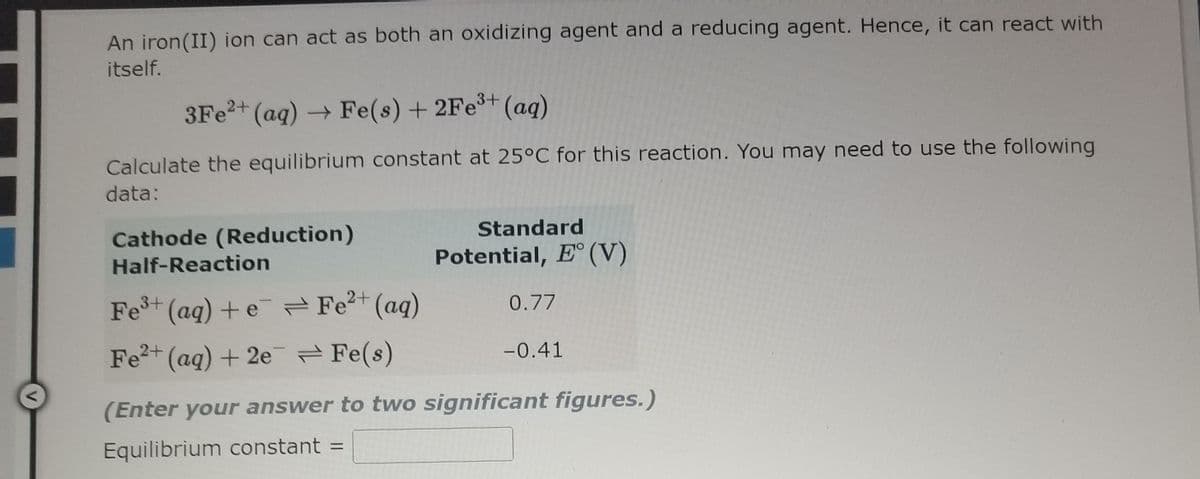An iron(II) ion can act as both an oxidizing agent and a reducing agent. Hence, it can react with itself. 3FE2+ (aq) → Fe(s) + 2Fe3+ (aq) Calculate the equilibrium constant at 25°C for this reaction. You may need to use the following data: Cathode (Reduction) Standard Half-Reaction Potential, E° (V) Fet (aq) + e Fe?+ (aq) Fe2+ (aq) + 2e Fe(s) 0.77 -0.41 (Enter your answer to two significant figures.) Equilibrium constant =
An iron(II) ion can act as both an oxidizing agent and a reducing agent. Hence, it can react with itself. 3FE2+ (aq) → Fe(s) + 2Fe3+ (aq) Calculate the equilibrium constant at 25°C for this reaction. You may need to use the following data: Cathode (Reduction) Standard Half-Reaction Potential, E° (V) Fet (aq) + e Fe?+ (aq) Fe2+ (aq) + 2e Fe(s) 0.77 -0.41 (Enter your answer to two significant figures.) Equilibrium constant =
Chemistry & Chemical Reactivity
10th Edition
ISBN:9781337399074
Author:John C. Kotz, Paul M. Treichel, John Townsend, David Treichel
Publisher:John C. Kotz, Paul M. Treichel, John Townsend, David Treichel
Chapter19: Principles Of Chemical Reactivity: Electron Transfer Reactions
Section19.9: Corrosion: Redox Reactions In The Environment
Problem 2.4ACP: The overall reaction for the production of Cu(OH)2 from Cu in oxygenated water can be broken into...
Related questions
Question

Transcribed Image Text:An iron(II) ion can act as both an oxidizing agent and a reducing agent. Hence, it can react with
itself.
3FE2+ (aq) Fe(s) + 2Fe+ (aq)
Calculate the equilibrium constant at 25°C for this reaction. You may need to use the following
data:
Cathode (Reduction)
Standard
Half-Reaction
Potential, E° (V)
Fet (aq) +e Fe?+ (aq)
0.77
Fe2+ (aq) + 2e = Fe(s)
-0.41
(Enter your answer to two significant figures.)
Equilibrium constant =
Expert Solution
This question has been solved!
Explore an expertly crafted, step-by-step solution for a thorough understanding of key concepts.
This is a popular solution!
Trending now
This is a popular solution!
Step by step
Solved in 2 steps with 2 images

Knowledge Booster
Learn more about
Need a deep-dive on the concept behind this application? Look no further. Learn more about this topic, chemistry and related others by exploring similar questions and additional content below.Recommended textbooks for you

Chemistry & Chemical Reactivity
Chemistry
ISBN:
9781337399074
Author:
John C. Kotz, Paul M. Treichel, John Townsend, David Treichel
Publisher:
Cengage Learning

Principles of Modern Chemistry
Chemistry
ISBN:
9781305079113
Author:
David W. Oxtoby, H. Pat Gillis, Laurie J. Butler
Publisher:
Cengage Learning

Chemistry
Chemistry
ISBN:
9781305957404
Author:
Steven S. Zumdahl, Susan A. Zumdahl, Donald J. DeCoste
Publisher:
Cengage Learning

Chemistry & Chemical Reactivity
Chemistry
ISBN:
9781337399074
Author:
John C. Kotz, Paul M. Treichel, John Townsend, David Treichel
Publisher:
Cengage Learning

Principles of Modern Chemistry
Chemistry
ISBN:
9781305079113
Author:
David W. Oxtoby, H. Pat Gillis, Laurie J. Butler
Publisher:
Cengage Learning

Chemistry
Chemistry
ISBN:
9781305957404
Author:
Steven S. Zumdahl, Susan A. Zumdahl, Donald J. DeCoste
Publisher:
Cengage Learning

Chemistry: An Atoms First Approach
Chemistry
ISBN:
9781305079243
Author:
Steven S. Zumdahl, Susan A. Zumdahl
Publisher:
Cengage Learning


Chemistry: Principles and Practice
Chemistry
ISBN:
9780534420123
Author:
Daniel L. Reger, Scott R. Goode, David W. Ball, Edward Mercer
Publisher:
Cengage Learning